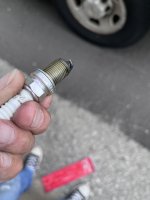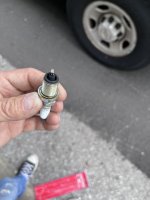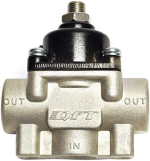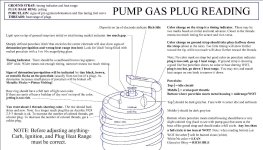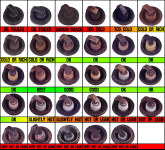Car started running like it was running out of gas yesterday but plenty in the tank, new Holley 130 GPH mech pump But I’m thinking the carb needs a rebuild but does this look like it was leaning out? Maybe acc pumps in carb is shot? I only pulled the 5 easy plugs but sure they all look alike, and acted flooded when I left a store and again when I left my house to bring back to the rental garage
Old Chevelles
Welcome to OldChevelles.com, built by Auto Enthusiasts for Auto Enthusiasts. Cars are not our only interests so please feel free to post about any subject the community might enjoy or you just feel you need to air.
We respect free speech and constructive dialogue however we don't allow threatening talk against members, nudity, or pornography. Threads are monitored and trolls are not tolerated.
This site is completely free and there are no costs. Please enjoy and provide feedback.You are using an out of date browser. It may not display this or other websites correctly.
You should upgrade or use an alternative browser.
You should upgrade or use an alternative browser.
Spark Plug Reading
- Thread starter Shovelrick
- Start date
Those are way too rich (almost black).
They should ba a medium "tan" color.
I've always been afraid of those high-capacity fuel pumps thinking they will overpower the needle and seat.
But others on here have lots of experience with racing.
They should ba a medium "tan" color.
I've always been afraid of those high-capacity fuel pumps thinking they will overpower the needle and seat.
But others on here have lots of experience with racing.
I would check your float level, just to rule that out.
Definitely to fat. Carbureted?
I’ve done that recently but I’ll check it again but I’m really thinking to pull it and go through it, it came of a 71 Chevelle with a 750hp 540ci when the guy went EFI so needs to be set up for my engine anyway, I have a phone number for the guy I bought the 3310 750 I left on the 454 I sold my friend, the guy also has a carb flow bench so should be able to set this perfectly to the 489,,, I’d think anywayWay too rich and too much fuel being dumped in. I agree with Brian to check your float is okay, and adjusted correctly.
It is worth it (at least for me) to have your carb set up by a pro or buy a carb from them.
IMHO, this is maybe the best carb to run on the street. It's a 750 that's rated 850 cfm because they removed the choke and streamlined everything.
So it has better low end response. It's a double-pumper 4 corner idle. $720 new and $450 factory refurbished.
 www.holley.com
www.holley.com
So it has better low end response. It's a double-pumper 4 corner idle. $720 new and $450 factory refurbished.
Holley 0-82851SA 850 CFM Aluminum Street HP Carburetor
Tire smoking performance has never been so affordable! The all new Aluminum Street HPs weigh up to 40% less and are even easier on your wallet. Holley is proud to introduce the all new Aluminum Street HP™. They utilize the best features from Holley's Race Bred 4150 HP™ carbs, but are tamed for...
cage2592
Administrator
@ 130GPH mech pump, are you running a fuel regulator and pressure gauge? since you stated a new fuel pump, I'm guessing you are overpowering the needle and seat as Beth suggested above. Looks like that Holley is a 7.5 - 9psi preset. Id throw a regulator on it and set it to 6psi. I run a Holley 170gph and my psi is set at 5.5. I run an AED 850 carb and they recommended 7psi MAX for this and my previous 750. My regulator is set to 5.5 as its dead-headed and has a tendancy to 'pressure creep' and spike from 6 to 6.5. My floats are at the botom 1/3 of the sight glass.
I think you are getting to much fuel. Especially if you get on it and let off abruptly.
I think you are getting to much fuel. Especially if you get on it and let off abruptly.
I need to add a regulator too. Seems that's a very common problem with fuel pumps - too much pressure.
cage2592
Administrator
Not bad for 40$. I run a regulator and gauge always and no matter the engine as i want to ensure proper pressure and the number.
Though I wouldn't recommend it now, I run the below on the 70. I'm not a Holley anything fan since they started buying companies and pushing the market to junk overseas.
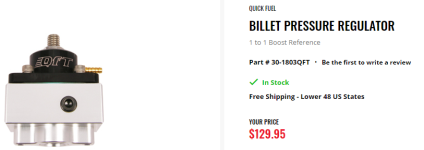
****The last regulator I bought months ago is this Mc Robb. It has been amazing. I'm switching the Chevelles QFT to this.
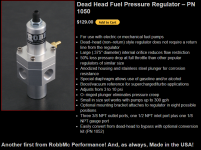
I also keep the regulator away from the engine (lower left in the picture) and run the fuel supply line in a long bow away from the engine and parts. This keeps the fuel cooler and not locking up.
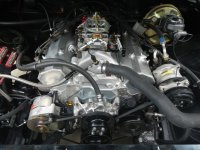
This was engine running. Zoomed in on the pressure gauge, you can see it reading about 5.8psi.
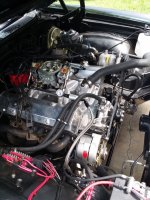
Though I wouldn't recommend it now, I run the below on the 70. I'm not a Holley anything fan since they started buying companies and pushing the market to junk overseas.

****The last regulator I bought months ago is this Mc Robb. It has been amazing. I'm switching the Chevelles QFT to this.

I also keep the regulator away from the engine (lower left in the picture) and run the fuel supply line in a long bow away from the engine and parts. This keeps the fuel cooler and not locking up.

This was engine running. Zoomed in on the pressure gauge, you can see it reading about 5.8psi.

I do have a regulator set at 6.5 and has a gauge on it, the plugs looking Fat but the end of the ground strap being so light colored had me wondering what’s happening?@ 130GPH mech pump, are you running a fuel regulator and pressure gauge? since you stated a new fuel pump, I'm guessing you are overpowering the needle and seat as Beth suggested above. Looks like that Holley is a 7.5 - 9psi preset. Id throw a regulator on it and set it to 6psi. I run a Holley 170gph and my psi is set at 5.5. I run an AED 850 carb and they recommended 7psi MAX for this and my previous 750. My regulator is set to 5.5 as its dead-headed and has a tendancy to 'pressure creep' and spike from 6 to 6.5. My floats are at the botom 1/3 of the sight glass.
I think you are getting to much fuel. Especially if you get on it and let off abruptly.
cage2592
Administrator
You could try it at 6psi and readjust the floats. I'm assuming your spark plugs and everything drove normal prior to the new fuel pump. Where they wet after that run? Did it sit at idle long? They look more dry to me like new carbon buildup. Air filter good? Coil good? Any could cause carbon buildup. I say this because they all look exactly the same. I had a coil go out in another car one time and the plugs looked like that prior to the coil going. All the same, but it was losing spark and plugs looked lightly black like that or sooty.
Anyone else's thoughts?
Anyone else's thoughts?
I came across this on a 3rd gen Camaro website. Sounds like good advice to me - it's a "sticky" on their website
Re: need help tuning my holley
On a Holley, 1 jet size is an imperceptibly small step. 2 jet sizes is a tiny but noticeable step. 3 jet sizes is a standard adjustment. 4-5 jet sizes is a big step.
Look at your primary jets. Whatever size they are, buy some that are 2 sizes, 4 sizes, 5 sizes, and 6 sizes smaller; and 2 sizes larger. You'll be needing them.
First, set the fuel level. If it has sight plugs, set the primary one to where gas dribbles out while the engine is idling, when you just bump the fender; and set the sec one to where you have to jiggle the car pretty good to get it to come out.
Lean the primary jets (using the "step size" description above) until the car just barely starts to surge while cruising (55-60 mph) at a steady speed on a level highway and it starts going up a hill. Ignore all other misbehavior of any kind for the time being. Once you find that point, go back up 2 jet sizes.
Once you get it to do that, look at the primary side power valve. If it's stock, it's probably a 65. Stupid. Raise the value until the flat spot goes away when you're in high gear and driving along at about 35 mph (basically, as slow as you can possibly go in high gear), and you give it gas. It'll take a MUCH higher number power valve.... probably a 105 or a 125. If it starts giving you the burn-your-eyes idle, go back down one step.
When you get that right, set the idle speed right (800 RPM out of gear, say); then get the idle mixture right by turning each pimary idle screw in until the RPM drops, then back it back out 1/8 turn. Shut the motor off, and average the 2 screws (like, if one is 5/8 turn out, and one is 7/8 turn out, set them both to 3/4 turn out), and restart the motor, and check them again. Repeat until they're equal, or until you have determined that they absolutely CANNOT be made equal. In no case should they be more than 1/8 turn different.
Take the carb off, flip it over, and look at the transition slot. You want less than .050" of it exposed below the pri throtle blades. If more of it is exposed than that (it will be), open the sec throttles with their idle screw, 1/8 turn; put the carb back on; re-set the idle speed and mixture; then pop the carb back off and look at it. Repeat until you have between .030" and .050" of the transition slot showing.
At this point, the thing should run like a bat outta hell, on the primaries. The secondaries could be just about anywhere. Put a 65 power valve in them, if they don't already have that; and select jets for max ¼ mile mph.
At that point, you'll have your Holley set up better than about 95% of all other Holley owners. You'll be getting nearly the same gas mileage as you would with a Q-jet, and you'll be making 20% more power than most cars with the same cam & heads, and FI.
--------------
Tuning tips from Sean Murphy smicarburetor.com
Float Level- The fuel level in the bowls should be set at the bottom of the sight hole so that you have to jostle the car to get the fuel to come out the sight hole when running. We set the floats in the shop to a particular setting; but fuel pressure dictates fuel level. Therefore you must set this when you first install the carburetor. Finally, after setting the floats, always give the carburetor time to burn off enough fuel to reopen the needle/seat so that your new setting is really what you are seeing. Many times people lower the floats too much because they haven?t waited a sufficient amount of time for the fuel to burn off and the new setting to take.
Throttle Blade Adjustment- The throttle blades should be set at an rpm that is as low as possible to keep the transfer slots covered at closed throttle position. If you should lose your setting just back it completely off, put 1 round in the primary and 1 round in the secondary and start there.
Idle Mixture Screws- Always adjust the 4 idle mixture screws evenly. The settings on all 4 should be the same. Our original setting is 1 1/2 turns out. If for some reason your engine absolutely needs a different setting on one side or corner you can just about bet something is wrong with the engine causing it to have a different signal/vacuum on that side/corner.
Fuel Pressure- 6.0 to 6.5 pounds. You should absolutely know what your fuel pressure is! Many racers have no clue what their fuel pressure is, and they chase engine problems for weeks when a simple fuel pressure gauge would have indicated the problem straight away.
Vent Tube Clearance- You must have at least �” clearance above the vent tubes. It is ok to lower the vent tubes if absolutely necessary, but you will begin to run the risk of fuel spilling over in the turns if you are not careful.
Pump Circuit Tuning- Because of the differences in track conditions and driving styles you may need to adjust the pump circuit, i.e. pump cam/pump arm, to correct “off corner” stumbling issues. If an engine stumbles two or three times after the driver steps into the throttle this usually indicates too much fuel and can be corrected by adjusting slack in the pump arm or installing a smaller pump cam. If an engine has a “dead hesitation” and then picks right up and goes, this usually indicates not enough fuel on the pump circuit. First check that the pump arm has no slack in the adjustment then proceed to increase pump shot with either a larger pump cam or a larger pump nozzle.
Re: need help tuning my holley
On a Holley, 1 jet size is an imperceptibly small step. 2 jet sizes is a tiny but noticeable step. 3 jet sizes is a standard adjustment. 4-5 jet sizes is a big step.
Look at your primary jets. Whatever size they are, buy some that are 2 sizes, 4 sizes, 5 sizes, and 6 sizes smaller; and 2 sizes larger. You'll be needing them.
First, set the fuel level. If it has sight plugs, set the primary one to where gas dribbles out while the engine is idling, when you just bump the fender; and set the sec one to where you have to jiggle the car pretty good to get it to come out.
Lean the primary jets (using the "step size" description above) until the car just barely starts to surge while cruising (55-60 mph) at a steady speed on a level highway and it starts going up a hill. Ignore all other misbehavior of any kind for the time being. Once you find that point, go back up 2 jet sizes.
Once you get it to do that, look at the primary side power valve. If it's stock, it's probably a 65. Stupid. Raise the value until the flat spot goes away when you're in high gear and driving along at about 35 mph (basically, as slow as you can possibly go in high gear), and you give it gas. It'll take a MUCH higher number power valve.... probably a 105 or a 125. If it starts giving you the burn-your-eyes idle, go back down one step.
When you get that right, set the idle speed right (800 RPM out of gear, say); then get the idle mixture right by turning each pimary idle screw in until the RPM drops, then back it back out 1/8 turn. Shut the motor off, and average the 2 screws (like, if one is 5/8 turn out, and one is 7/8 turn out, set them both to 3/4 turn out), and restart the motor, and check them again. Repeat until they're equal, or until you have determined that they absolutely CANNOT be made equal. In no case should they be more than 1/8 turn different.
Take the carb off, flip it over, and look at the transition slot. You want less than .050" of it exposed below the pri throtle blades. If more of it is exposed than that (it will be), open the sec throttles with their idle screw, 1/8 turn; put the carb back on; re-set the idle speed and mixture; then pop the carb back off and look at it. Repeat until you have between .030" and .050" of the transition slot showing.
At this point, the thing should run like a bat outta hell, on the primaries. The secondaries could be just about anywhere. Put a 65 power valve in them, if they don't already have that; and select jets for max ¼ mile mph.
At that point, you'll have your Holley set up better than about 95% of all other Holley owners. You'll be getting nearly the same gas mileage as you would with a Q-jet, and you'll be making 20% more power than most cars with the same cam & heads, and FI.
Holley Tuning - Third Generation F-Body Message Boards
Carburetors - Holley Tuning - On a Holley, 1 jet size is an imperceptibly small step. 2 jet sizes is a tiny but noticeable step. 3 jet sizes is a standard adjustment. 4-5 jet sizes is a big step. Look at your primary jets. Whatever size they are, buy some that are 2 sizes, 4 sizes, 5 sizes, and...
www.thirdgen.org
Tuning tips from Sean Murphy smicarburetor.com
Float Level- The fuel level in the bowls should be set at the bottom of the sight hole so that you have to jostle the car to get the fuel to come out the sight hole when running. We set the floats in the shop to a particular setting; but fuel pressure dictates fuel level. Therefore you must set this when you first install the carburetor. Finally, after setting the floats, always give the carburetor time to burn off enough fuel to reopen the needle/seat so that your new setting is really what you are seeing. Many times people lower the floats too much because they haven?t waited a sufficient amount of time for the fuel to burn off and the new setting to take.
Throttle Blade Adjustment- The throttle blades should be set at an rpm that is as low as possible to keep the transfer slots covered at closed throttle position. If you should lose your setting just back it completely off, put 1 round in the primary and 1 round in the secondary and start there.
Idle Mixture Screws- Always adjust the 4 idle mixture screws evenly. The settings on all 4 should be the same. Our original setting is 1 1/2 turns out. If for some reason your engine absolutely needs a different setting on one side or corner you can just about bet something is wrong with the engine causing it to have a different signal/vacuum on that side/corner.
Fuel Pressure- 6.0 to 6.5 pounds. You should absolutely know what your fuel pressure is! Many racers have no clue what their fuel pressure is, and they chase engine problems for weeks when a simple fuel pressure gauge would have indicated the problem straight away.
Vent Tube Clearance- You must have at least �” clearance above the vent tubes. It is ok to lower the vent tubes if absolutely necessary, but you will begin to run the risk of fuel spilling over in the turns if you are not careful.
Pump Circuit Tuning- Because of the differences in track conditions and driving styles you may need to adjust the pump circuit, i.e. pump cam/pump arm, to correct “off corner” stumbling issues. If an engine stumbles two or three times after the driver steps into the throttle this usually indicates too much fuel and can be corrected by adjusting slack in the pump arm or installing a smaller pump cam. If an engine has a “dead hesitation” and then picks right up and goes, this usually indicates not enough fuel on the pump circuit. First check that the pump arm has no slack in the adjustment then proceed to increase pump shot with either a larger pump cam or a larger pump nozzle.
Last edited:

